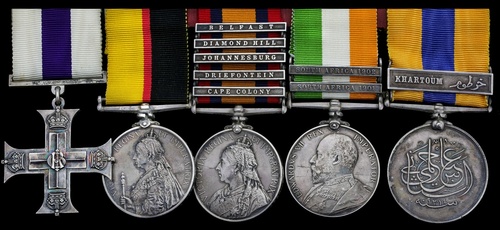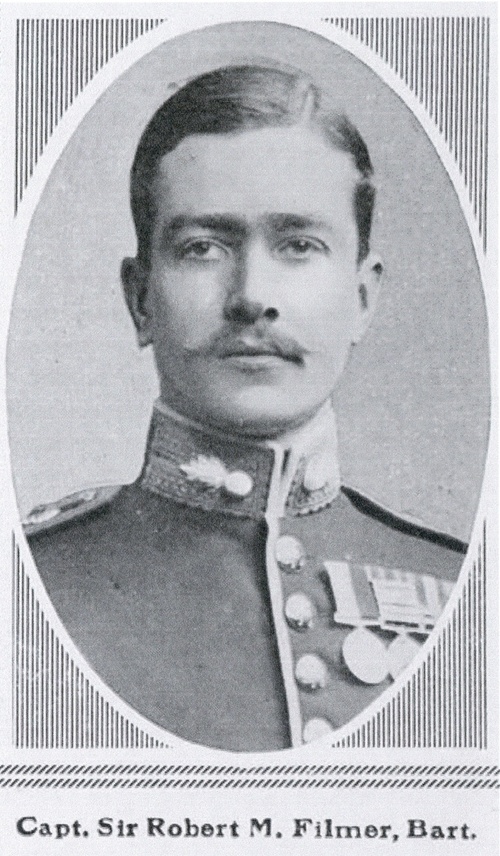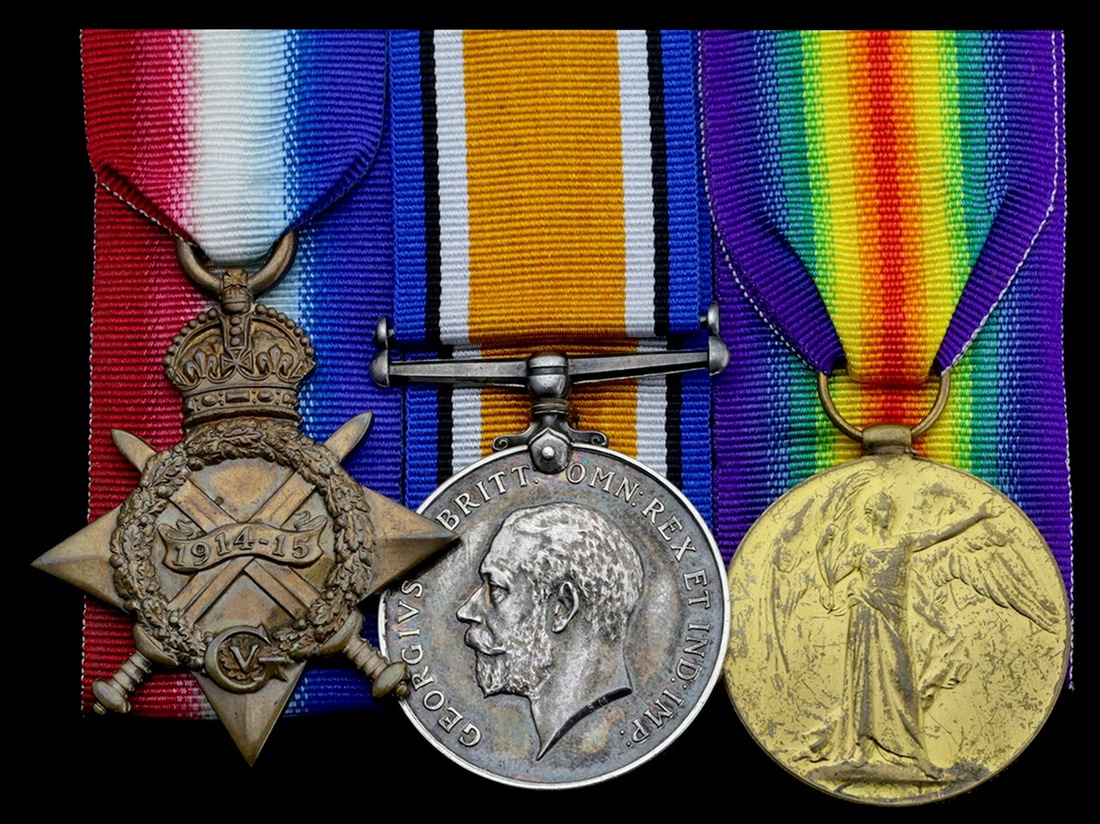Auction: 20001 - Orders, Decorations and Medals - conducted behind closed doors
Lot: 664
'Sir Robert Marcus Filmer, M.C., died of wounds, in 1916. Leaving the front line trenches after a spell of duty, he discovered that his pince-nez glasses had been left in his dug-out. Returning to retrieve them, he was mortally wounded. With his death the baronetcy became extinct.'
Filmer's demise as recounted in Seven Generations of a Kent Family (1975).
The exceptional Great War 'trench raider's' immediate M.C. group of eight to Sir R. M. Filmer, Bart., Grenadier Guards, who led a daring and highly successful raid into German trenches in December 1915, only to be killed a month later by a stray shell while searching for his glasses
Military Cross, G.V.R., unnamed as issued; Queen's Sudan 1896-98 (2/Lt. Sir R. Filmer Bt. 1/Gren:Grds:); Queen's South Africa 1899-1902, 5 clasps, Cape Colony, Driefontein, Johannesburg, Diamond Hill, Belfast (Lieut: Sir R. M. Filmer, Bt, Gren: Gds:); King's South Africa 1901-1902, 2 clasps (Lieut. Sir. R. M. Filmer. Bt. Gren.Gds.), officially impressed naming; Khedive's Sudan (2nd Lieut Sir Robert Filmer. Grenadier. Guards. 1898.), naming officially engraved in block capitals; 1914-15 Star (Capt. Sir R. M. Filmer. Bt. G.Gds.); British War and Victory Medals 1914-19 (Capt. Sir R. M. Filmer. Bt.), the first loose, the second, third, fourth and fifth mounted in cavalry style by Spink & Son as worn, the last three recently mounted in court style, nearly extremely fine (8)
M.C. London Gazette 22 January 1916:
'For conspicuous gallantry and skill near Neuve Chapelle on the night of 11th/12th December 1915. He made a reconnaissance of the German trenches previous to a successful attack, crawling down the entire length of one trench to a point where it joined another, finding out the best points to attack and the weak spots in the wire. The success of the enterprise was largely due to his reconnaissance and subsequent gallant conduct in the trenches.'
Robert Marcus Filmer was born on 25 February 1878, the youngest son of Sir Edmund Filmer, 9th Baronet and The Hon. Lady Georgina Caroline Filmer of East Sutton Park, Maidstone, eldest daughter of Lord Arthur Marcus Hill. He succeeded his father as 10th Baronet in 1886, aged just eight years. Educated at Eton from 1892-96, he played Fives for his house and was elected to the House Debating Society in 1896. One of his debating opponents was Winston Churchill, representing Harrow.
Filmer attended the Royal Military Academy, Sandhurst and was gazetted as a 2nd Lieutenant with the Grenadier Guards in February 1898. He served with the 1st Battalion in the 1898 Nile Expedition, and was present at the Battle of Omdurman on 2 September 1898. The Grenadier Guards landed at Khartoum two days previously and held the left-centre of the British line during this famous action. Filmer then took part in the 2nd Boer War, arriving in the Orange Free State in February 1900. He fought at Poplar Grove, Driefontein, Vet River (5-6 May) and Zand River. Operations in Transvaal included Diamond Hill (11-12 June) and Belfast (26-27 August). On 27-29 November he served at Caledon River in Orange Free State. Returning home in 1902, Filmer resigned his regular commission and joined the East Kent Yeomanry in 1907, rising to Major on 2 August 1912. He twice stood for election as a Conservative M.P., first in North-West Durham in 1906 and then in Lincoln in 1910. Both attempts were unsuccessful.
The onset of the Great War saw Filmer return to what he knew best. Joining the newly-formed 4th Battalion, Grenadier Guards in early 1915, he arrived in France on 27 July that year, serving with No. 3 Company throughout the campaign. Led by Colonel Lord H. Seymour, the Battalion left billets at Annequin on 23 October and entered trenches opposite the Hohenzollern Redoubt. German shelling had reduced these trenches to a tangled morass, and considerable work had to be done to make them serviceable. Brigadier-General Heyworth inspected the trenches and praised the 4th Battalion for the zeal with which it set about this task. Two days later the Battalion retired to Allouagne, where it remained until 14 November. It then marched to Pont du Hem along the La Bassée Road, via Estaire, garrisoning trenches between Chapigny and Winchester Road. Every 48 hours it was relieved, returning to billets. This routine went on for nearly a month. On 12 December, the 4th Battalion carried out a brilliant raid which captured a German trench at very little cost to themselves. Filmer showed particular bravery and presence of mind on this occasion. The Regimental History records:
'At 8.15 p.m. Captain Sir Robert Filmer, accompanied by Sergeant Higgins and three men in No. 3 Company, went out to make a preliminary reconnaissance. By crawling right up to the enemy's trenches he succeeded in locating the exact position of the German machine-guns, and was able to confirm the report as to the gap in the enemy's wire entanglements. Captain Sir R. Filmer, who had already earned a name for bravery, crept quite alone down the entire length of the German trench, and carefully noted all he saw. On his return to our line the final orders were issued to the raiding party, consisting of thirty-three men from No. 3 Company, and the Battalion bombers under Lieutenant G. Ponsonby. The night was very dark, and it was difficult to see any landmarks. Sergeant Higgins led the party over the parapet at 11 p.m., and was followed by Captain Sir R. Filmer and a covering party. Silently they advanced, but lost direction slightly to the left, with the result that they missed the gap and found themselves held up by low wire entanglement. Sir R. Filmer came up to ascertain the cause of the delay, and after considering the situation decided to cut the wire and rush the trench. The wire-cutting was successfully done, although only a few yards from the German line, and the party, headed by Sergeant Higgins, dashed into the trench....
The bombing and bayoneting began in earnest, and the Germans were completely cleared out of the trench. The machine-guns, which were found to be too securely fixed to take away, were destroyed by bombs. It was during this trench fighting that the bombing officer, Lieutenant G. Ponsonby, was badly wounded in the leg. Private W. Sweetman, finding him unable to move, carried him on his back under heavy fire to our lines. The other casualties were one man missing and three wounded. This small number of casualties proved how well arranged the raid had been, and how brilliantly it had been carried out.'
General Sir Douglas Haig was generous in his praise for this 'well planned and well-executed operation', and Filmer was personally congratulated by General Lord Cavan. He was subsequently awarded the Military Cross. Christmas Day 1915 was spent in billets at Laventie, the 4th Battalion moving into trenches just outside that town on 13 January 1916. Key strongpoints in that vicinity were A1 Redoubt, Flank Post, and Firework Post. These were subjected to heavy shelling by the German artillery. It was during one of these bombardments, on 25 January, that Filmer was mortally wounded. The Regimental History takes up the tragic story:
'He had just left the trenches when he found he had lost his glasses. Being very short-sighted, he determined to go back and look for them, although he was warned that the road was bring heavily shelled at the time. With that supreme contempt for all shells that characterised his whole conduct since he came out, he rode back when a shell burst close to him, killing his horse and wounding him so severely that he died the next day.'
Filmer died of his wounds at No. 2 London Casualty Clearing Station. He lies in Merville Communal Cemetery (Grave Ref. VII. A. 4), eight miles north of Bethune, and is also commemorated on a stained glass window at St. Peter & St. Paul's Church, East Sutton. This window shows him in Guards uniform. A member of the Guards, Turf, Carlton and Beefsteak Clubs, Filmer never married; the ancient Filmer baronetcy became extinct upon his death.
Sold with a large archive comprising genealogical research, extracts from Burke's Peerage and London Gazette entries, in addition to a copy of John L. Filmer's Seven Generations of a Kent Family (London, 1975).
Subject to 20% VAT on Buyer’s Premium. For more information please view Terms and Conditions for Buyers.
Sold for
£3,300
Starting price
£2100









